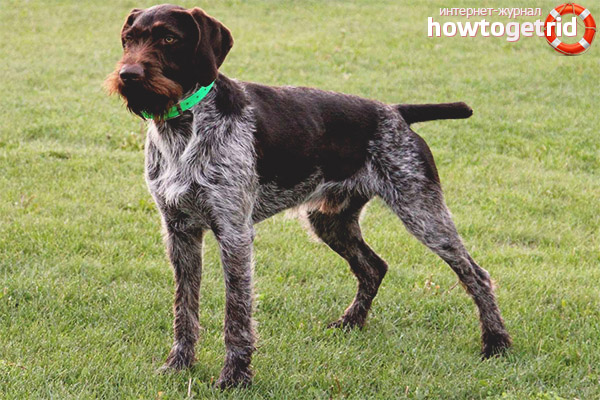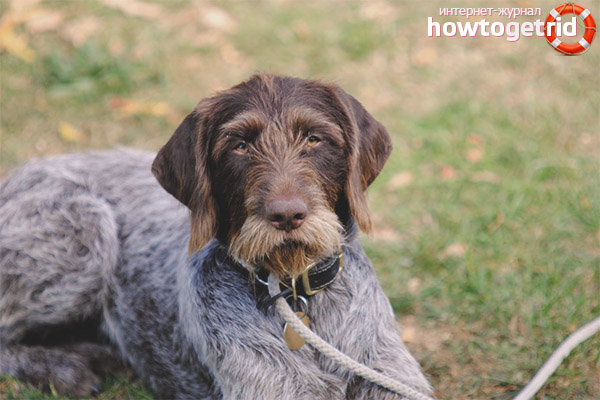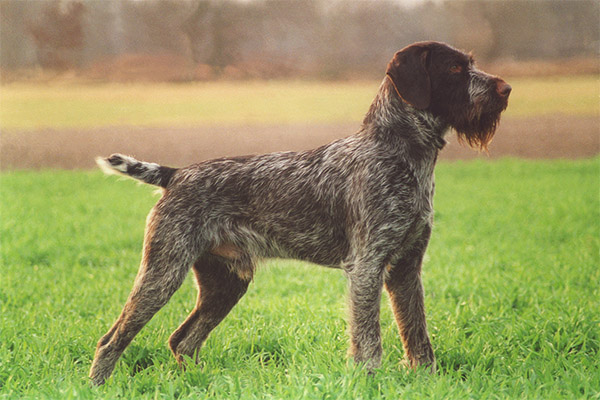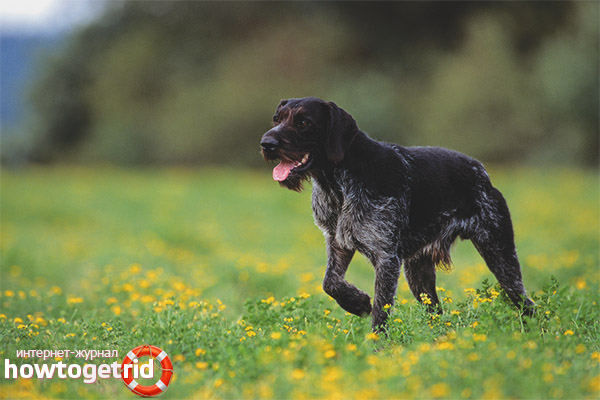The content of the article
- 1 From the history of the breed
- 2 Breed standards
- 3 Individual features of character
- 4 Hunting qualities
- 5 Content Features
- 6 Relationship with children
- 7 Relations with other animals
- 8 Nutrition
- 9 Grooming
- 10 Paws and claws
- 11 De-worming
- 12 Health
- 13 Purchase
- 14 How much is a drachtaar puppy?
- 15 Video: Drathaar dog breed
Choosing a pet, many bypass the hunting breeds. Everyone believes that their natural instincts will not bring peace to life. There is some truth in this assumption if they are talking about drachtaars. Besides the fact that they are great hunters, dogs of this breed are very intelligent, proud and have a strong character.
From the history of the breed
Deutsch Drathaar (German wire-haired cops) were bred in Germany at the end of the 19th century. It is authentically known that their ancestors are griffons, pointers, shtihelhaars and German short-haired cops. The hard coat of a dog of this breed became the cause of its name, the drathaar from it. "Wire-haired."
Even in spite of the German origin of the Dratskhaars, there are no references or descriptions about wire-haired dogs in the hunting books of the 16-18th century. They came to Germany from Northern France a little later in the person of their ancestors the Griffons, who interbred with the German cops, as a result of which a new breed appeared. In addition to the structure of wool, the Drathkaras inherited from them the eyebrows, mustache and beard.
For the first time, the mention of German wire-haired cops was recorded in the 97th year of the 18th century, and in 1813, Baron Borch described this breed. In 1829, Karl Kegel noted the difference between bristly and smooth-haired cops.
In the 19th century, barbed dogs were not particularly popular among German hunters. They were considered unattractive by external data and noted their poor hunting qualities. Individuals were crossed with more popular setters to improve the breed qualities. Most of them were used as pets and security guards, and only occasionally to assist in hunting.
During the Second World War, nobody was engaged in breeding the Drathkhaars. Most of the breeding individuals were destroyed in order to save food stocks.After the end of the war, through the efforts of breeders, the population of these animals was restored before the 65th year, together with the adoption of breed standards. For the purpose of high-quality selection, individuals with the best qualities of a hunter were selected, often neglecting external data.
In Russia, Drathkaras appeared after the Second World War, along with other trophy breeds. Today it is one of the most famous and popular hunting.
Breed standards
This noble animal belongs to the gun dogs. When evaluating at exhibitions, external data and working abilities of individuals are taken into account.
According to FCI standards, typical Drathyar have the following breed characteristics:
- Appearance. Powerful, strong, decisive and quick-witted. Their appearance corresponds to the internal content. Drathaar - ardent, hardy, absolutely controlled by people.
- Weight. The unit is floating, but is in the range of 27-32 kg.
- The size. In males - from 61 to 68 cm. In females - from 57 to 64 cm.
- Torso It has a square or rectangular format. In females more elongated shape. With a fairly long, curved, muscular, without sagging skin of the neck.
- Head. It is proportional to the body, of medium size.The forehead is wide and almost flat, rounded at the nape and sides. With pronounced cheekbones and brow ridges. At the end, the muzzle is rounded and decorated with a beard, which visually makes it square. Lips have pigmentation in the color of the base coat.
- Eyes. Small in size. Have an average landing. The irises are saturated dark brown. The whites of the eyes are covered with eyelids and painted according to the basic tone of the coat.
- Nose. Wide with a crook. Nostrils are round.
- Ears. Medium thickness. Round. Hang down and slightly raised in the area of cartilage. When the dog is focused, turn in the direction of the nose.
- Paws. Muscular and straight. They are proportional to the body length and symmetrical to each other. Brushes are round, stable, tightly assembled. Pillows paws are the same color as the main color.
- Tail. Forms a straight line with the back. It was most often arrested, but if not, it has a saber form.
- Wool. Tight, adjacent to the body. The length of the guard hair is about 3 cm, but not less than 2 and not more than 4. In the area of the paws of the abdomen and chest, its length is shorter, this is on other parts of the body. On the face shorter hair. Characterized by a very dense, waterproof undercoat.In the area of the cheeks, eyebrows and beard, the coat is longer than over the entire head, which creates the impression of beardiness (buniness).
Colors:
- Gray-haired (gray).
- Black alternates with gray.
- Brown with gray hair.
- Brown with white spots in the sternum.
Any type of color may be spotted.
Individual features of character
Drathaar are faithful animals that have a set of positive universal qualities of a companion dog. Very well trained and inquisitive. At a young age, as a rule, they have a strong and stubborn disposition. Tend to compete with their masters in terms of leadership. Sometimes the nature of these animals does not allow owners to achieve success in training. Therefore, it is better to entrust the professionals.
Hunting qualities
Buying an animal for hunting assistance involves taking on a large responsibility owner. Most often, the hunter prefers hunting qualities over the exterior. To get a license to hunt, you need breeding documents and certificates of passing tests. A puppy must necessarily be trained elementary teams before vaccination. During walking, dogs are trained in primary teams, and after - more difficult.
Before moving on to special activities with puppies, they are trained for courage by eliminating fears of loud and sudden sounds, water and other possible annoying factors.
Specialized training conducted by imitating the process of hunting. To do this, they release birds from the shelter, most often quails, and train the dog not to move until the team. Then dogs are taught to hunt a certain type of living creatures. Drathaar can be adapted to any kind of loot.
Upon reaching the dog of a mature age, training is carried out in the form of a game. With adults individuals are trained at the practice level. In no case should not encourage aggression on the part of the dog, as well as to show it yourself.
Adult individuals are ideal universal hunters. Representatives of this breed are leaders among dogs of hunting breeds. Due to their harsh hair, they are not vulnerable to natural conditions of damage to the skin integument by bumpy plants and bushes, through which sometimes one has to wade for prey.
Content Features
Drathaar is not a sofa pet.It is better to keep it in a private sector, in the yard in the aviary. At the same time, it is necessary to equip a warm booth on the territory of housing, in which the animal can hide from the weather. The thick undercoat of the Drathkhaars prevents them from freezing even in thirty degrees of frost. Besides the fact that they are excellent hunters, they also have excellent protective qualities, have a developed sense of territory and are not aggressive at the same time. They are not inclined to show confidence in others, and are devoted only to their owners and the family in which they live. Sometimes the owner and himself must go the hard way in order to reach an understanding with their own pet.
Living the dog in an open-air cage does not save the owner from having to walk. Walking this large and active animal is necessary on a leash. It is advisable to provide your pet with active leisure in nature or in the area close to it.
Toddlers Drathaara quite clever and inquisitive. They are rarely prone to the inherent puppies of puppies, especially with elementary rearing. In order to maximally protect oneself from damage to property by a dog, it must be loaded as much as possible with walks and games.The positive impact of the presence of special toys to occupy a pet. The use of physical punishments and raising the voice in relation to an animal can develop a number of complexes in it and is unacceptable.
Relationship with children

Drachtaars often become friends with children and love to play with them, but this does not apply to babies. At too early age a child may cause discomfort to the dog, which will cause hostility from the pet. In rare cases, these animals tend to show aggression. As a rule, an adult Drathaar simply ignores small children. As for puppies, they better adapt to obsessive babies and can find common language with them. But still you should not leave an animal with young children unattended.
Relations with other animals
This breed of dogs is not considered aggressive, so they can be kept with other representatives of the animal world in the house, if they were there before the puppy. Otherwise, the cops can sneer at weaker pets, training their hunting abilities on them.
As for rodents and birds, they are unlikely to become best friends with the Drathaar, who are used to seeing them as prey rather than friends. There are exceptions, but very rarely.In order to avoid unpleasant situations you should not keep them in the same room with the alleged prey.
Nutrition
The first thing to do is to take the dog a special place for meals. Puppies need to be taught to eat in a special place for this purpose and on schedule. Otherwise there is a risk to get a beggar.
Experts recommend owners of dogs of this breed to feed an animal with natural products, giving them preference over ready-made dry food. But in fact, specialized food is more convenient during the hunt. The best food option is mixed. However, you should never mix both types of food in one feeding. In the conditions of the house they use natural food, and on the hunt - high-quality food. In the diet of the animal must necessarily contain lean types of meat, cereals and vegetables. It is necessary to avoid flour products, pickles, sweets and smoked meats. Fresh meat must be well frozen and processed with boiling water.
Puppies are fed about 4 times a day, in small portions. Adult animals eat 2-3 times depending on the volume of servings.It is necessary to give food to the pet after walks and trainings, but not before.
Grooming
The presence of a thick undercoat implies a mandatory combing during periods of molting. This should be done with the help of a comb with long, moderately thick teeth. The remains of down are removed with a wet hand or a special glove.
In summer, females lose most of their protective hair, so it is better to keep them indoors during periods of rain. Also, representatives of both sexes in wet weather during the molts should be protected from getting wet with special raincoats, otherwise the pet may catch a cold.
Bathing a pet should not be often. It is better to do this in the hot season, not more often 4-5 times a year. From frequent water procedures, the natural pH of the skin is impaired. What can cause peeling and pruritus. During bathing, you must use special dog shampoos or products for newborns. In no case can not apply cosmetic soap or human shampoos and shower gels.
Eyes and ears should be inspected several times a week and carried out with respect to their hygiene procedures every 7-10 days. The same goes for teeth.
Paws and claws

After walking, it is necessary to inspect the pet's paws for mechanical damage. If the dog lives in the house, it is necessary to wipe them with a damp cloth or washcloth. If cracks appear on the pads, it indicates that the animal receives less vitamins or fats. In this case, it is necessary to introduce into the diet vitamin complexes intended for large breed dogs. Damage to the antiseptic one-time or repeatedly, if there is inflammation.
De-worming
It is carried out once a quarter with the use of special anti-parasitic agents purchased at a veterinary pharmacy with strict observance of instructions and dosage rules. It is important for anthelmintic to take place before vaccinations in order to avoid complications, as well as before mating of both individuals in order to obtain healthy offspring.
Health
As a rule, animals of this breed have sufficiently strong health and minimal tendencies to popular canine diseases with proper care and maintenance. Most often, Drathkaras are subject to the following possible diseases:
- Dermatitis. It may occur due to frequent water treatments.
- Inflammation of the skin.
- Endocrine Disorders.
- Inversion of the intestines.
- Cataract.
- Atrophy of the retina.
- Cardiovascular pathologies.
Hip dysplasia. Appears in older dogs as a result of metabolic disorders. It is treated most often promptly.
The life expectancy of a Drathaar is on average about 15 years.
Purchase
Choosing the floor of the pet, you should consider for what specific purposes you need a dog. If a hunter is required, then a male is better. Since females can not be used during periods of leakage, pregnancy and raising offspring.
Puppies competent breeders do not implement up to 3 months. Since only on reaching this age can the pedigree data and the nature of the animal be determined.
How much is a drachtaar puppy?
It is necessary to buy an animal only in a specialized nursery from breeders with a good reputation. Purebred animals have a set of necessary qualities from the moment of birth. The price of such a puppy varies within 1000 USD in Russia and about 2500 in Europe.
It is not necessary to purchase an animal remotely or at too low a cost. Otherwise, there is a risk to get a home "ball" instead of a pedigree dog.
Video: Drathaar dog breed












To send